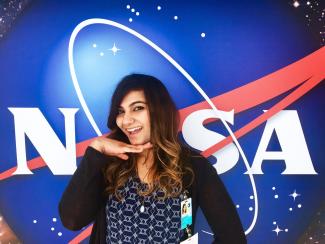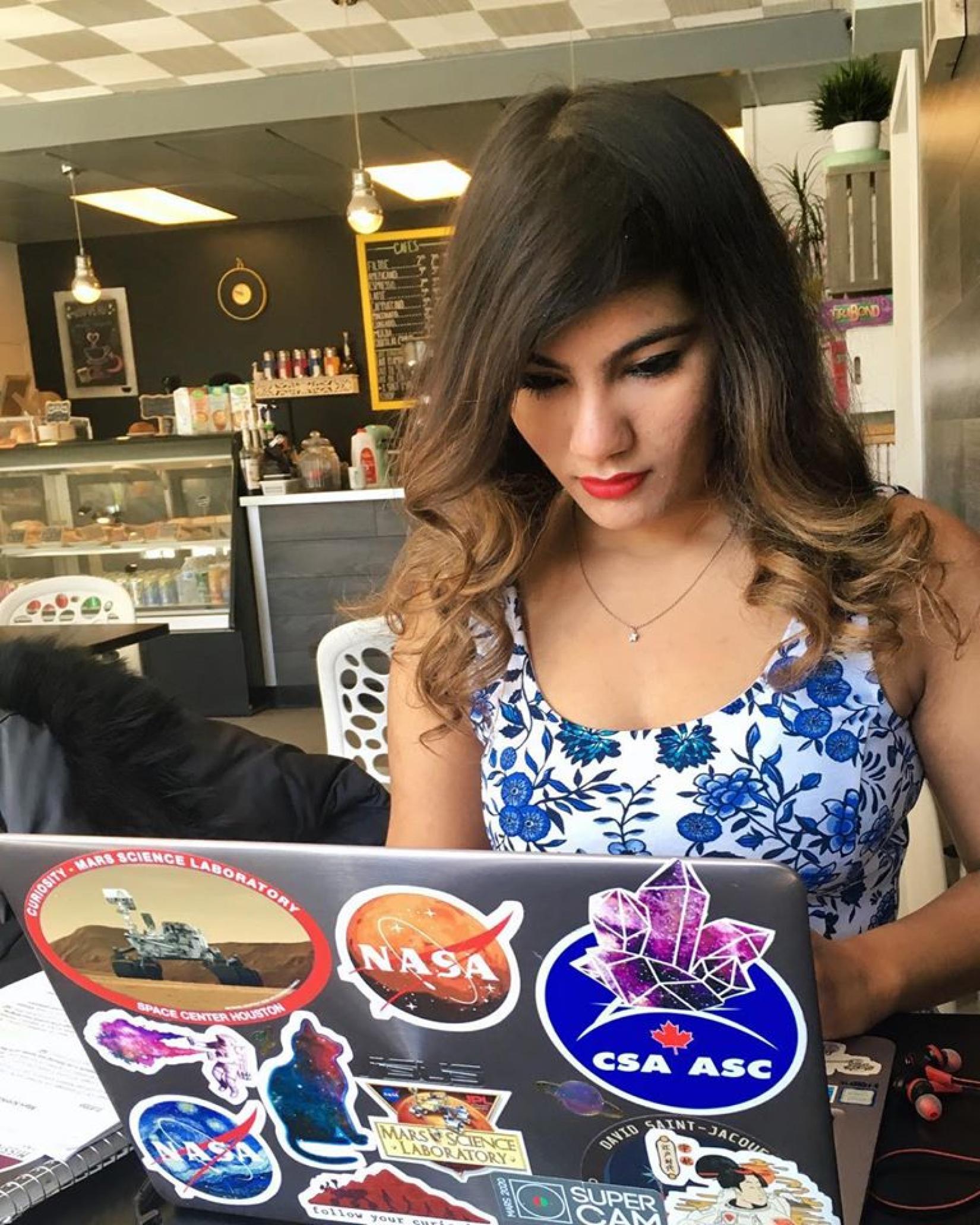30/07/2020 - 17:37
Debarati Das
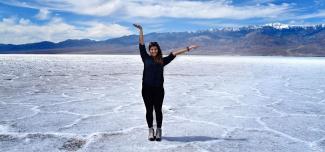
Space Faces: Studying Mars from Montréal
I woke up one night in May and couldn’t get back to sleep. After a while, I got out of bed and went for a walk in the park near my apartment just before the sun began rising.
As I walked into Parc La Fontaine, there, up in the sky were Jupiter and Saturn. Then, to the bottom-left of the two gas giants was Mars hovering just above the trees.
In 2019, Mars wasn’t visible to us, but in 2020, it is. And this year is a busy one for humans to send craft to the planet. As I write this, the United Arab Emirates and China have already sent craft there, and just this morning, NASA and ULA have successfully launched Perseverance towards the red planet, arriving in February of 2021.
On that sleepless May morning, I looked at Mars and thought: “There is something on our planet right now that will be on that dot in 7 months.”
That dot is roughly 100 million kilometres away, but there are people studying it right here in Montréal. And maybe you sit beside them in a café as they study the red planet.
The Workspace
“‘Why do you have such a tiny laptop? Get another screen!’”, Debarati tells me, describing what her supervisor says of her computer setup that she uses to study Mars data. “I just like small things and I can just carry it with myself everywhere.”
In these weird work-from-home times, I’ve become interested in how people have been getting their work done. Some people had their entire desk setup completely upended, but for others, like Debarati, it was mostly a matter of taking the laptop home and getting back to work.
“As long as there’s wifi and an outlet, I’m good. I’ll just start working on my little things and you probably wouldn’t know what I’m working on. Except for my stickers, which are just really loud and kinda out there.”
My parents were born before Sputnik was put into orbit in October, 1957. Years later, humans began sending probes to Mars. And now, people can pick up their portable supercomputers, head to a café, get data about that planet, and work on it. As accurate as Arthur C. Clarke was about describing the Internet and remote work in 1964, would he have assumed we would be so casual in our study of the planets?
Debarati did clarify, “I’ve never actually worked with the data at a café… mostly because I can’t focus on data processing when there are people talking around me. But I have worked on my paper (i.e., writing about the interpretation of the data) at cafés.”
Fair enough. Still cool. You could plop down at a café in Montréal and somebody beside you could potentially be writing about Mars.
Introductions
P. Astro: “Let’s say you’re at a party. How do you introduce yourself?”
Debarati: “It depends on what kind of party I’m at. I would say I’m a planetary geochemist – which translates to a grad student who works with rock chemistry of planetary material. But I specialize on Mars.”
P. Astro: “Do people’s eyes perk up? ‘You mean work with the planet Mars?’”
Debarati: “Yeah, that almost always happens. It’s fun because people – like my dentist – will ask me ’So, what do you do?’ So I’ll say, ‘Oh, I study Mars.’”
P. Astro: “Does it feel kinda cool to say that, though?”
Debarati: “Oh definitely. I kind of live for that. I’m convinced that I’m going to stay in this field just for that effect.”
Debarati grew up in Mumbai, India and then at 23 years old left for Japan to study at Okayama University. Now she’s a grad student at McGill University here in Montréal, a National Geographic Explorer, and a team member of the NASA Mars Science Laboratory team.
Rover Recap
Studying Mars isn’t a new thing. Humans have sent many spacecraft to flyby, orbit, and probe the planet starting from the early 1960s. But rovers – little robots that can move around on the surface – are a more rare breed. Currently, only 4 have had successful missions on Mars.
The first rover, the one that lit up my eyes as a 9 year old, was Mars Pathfinder which arrived in July 1997. This was about the size of a microwave and still looks cute (if your dog barks at it, it scurries away).
The next rovers, Spirit and Opportunity, landed in 2004. Bigger than Pathfinder, their missions were planned for 90 days, but ended up lasting for almost 7 and 14 years, respectively.
Curiosity, the largest rover yet, landed on the surface and has been operational since August 2012. The photo below shows the size difference between these three rover designs.
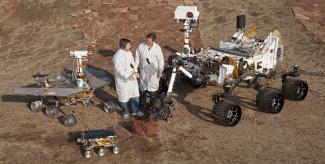
Curiosity is the public facing name of the rover, but for those that work deeper in the well of Mars exploration, you might hear it be called “Mars Science Laboratory” or "MSL" for short.
"The rover is basically a moving laboratory," says Debarati. It's loaded with instruments: cameras, spectrometers, radiation detectors, and environmental and atmospheric sensors. All roving around and powered by plutonium-238.
Shoot Rocks with Lasers
The instrument that Debarati receives data from and uses for her work is called ChemCam. It’s the big rectangular-looking instrument that peers above the top of the rover, which Debarati describes, “ChemCam has this instrument called LIBS (Laser-Induced Breakdown Spectrometer) which shoot lasers at the Mars rocks and collects data. Basically, it gives a complete elemental breakdown.”
How does shooting lasers at rocks help us find proof that life may have existed on Mars?
“It’s a high-powered laser beam and when it hits the surface of a rock, it basically forms a plasma. So it’s very hot and a certain light gets emitted. The components of the rock go to an elevated state of energy. As it cools down, it gives off all these different wavelengths and each chemical component.”
That’s the key bit: the different wavelengths that appear. Shoot the laser, look at the wavelength that gets emitted, and when you analyze that wavelength, you can tell what the rocks are made of.
Signs of Life and Boron
Look up from your screen and walk over to the Periodic Table you have pinned to your wall (you have one, right?) Look at the 5th element on the chart: Boron. How does this unassuming element give us clues for life?
Debarati: “Boron is a very water soluble element. It follows the water – it goes where the water goes.”
Throughout Gale Crater, the area on Mars where Curiosity roams, are mineral-filled cracks, or veinlets. “The mineral which fills these cracks and host the boron is calcium sulphate,” Debarati describes in this video:
Those cracks – those veinlets – are important: “The great thing about these little veinlets is that it is sort of sandwiched between these rocks and protects it from all the harmful radiations that are hitting the surface of Mars. So if there were Mars bugs, this would be a pretty great place for the Mars bugs to not get burnt down to a crisp.”
So, finding Boron is important because it supports the presence of water on Mars at one time. There’s two other important points about finding Boron: “Boron is also associated with finding neutral water that is not too hot and not too cold, similar to areas where we find Earth-like bacteria. Boron is also known to prolong the life for pre-biotic molecules on Earth.”
Debarati continues, "There are quite a lot of papers that state that boric acid was necessary for transforming organic molecules to life-forming structures. It’s not the only path, but it’s one of the key elements."
Her collaborator, Dr. Patrick Gasda, describes the importance of discovering Boron:
ChemCam, the instrument that shoots lasers at rocks, was responsible for finding Boron for the first time on Mars. 10 years ago, before Curiosity landed on Mars, we didn’t know if Boron was on the planet. Now we do.
The Upgrade: Perseverance
If you look at Curiosity and the new Perseverance rover, they look similar:
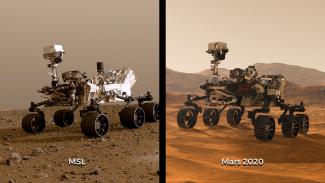
Let’s focus on ChemCam, the important camera and laser system that was used to find Boron. Is it the same?
Debarati: "Perseverance has a super version of ChemCam, which is why it’s called SuperCam. It’s like it levelled up. It has better cameras which are color, and it has a little microphone to listen to the winds and to the zaps as the laser is shooting."
Note: lasers don’t make *pew-pew* sounds. It’ll probably sound more like a brief *tick-tick* noise.
Curiosity, the rover that landed in 2012, was designed with a more geological aspect, whereas Perseverance is specifically looking for bio-signatures. And the location that it’s landing at is a prime suspect. With Curiosity, it landed in Gale Crater, but Perseverance will land in Jezero Crater, "the bottom of a vanished lake".
While roving along, it will collect samples that it will store on the surface. It’s later planned to pick these samples up and return them to Earth (this is quite a few years away, though).
There’s a lot new with the rover, and I recommend reading this brief article on the differences between the two rovers.
Path to Studying Mars
My assumption before interviewing Debarati was that studying Mars was a childhood dream come true. Turns out: nope.
“Everybody asks me that, and when I was a kid, I was really bad at school. I was that one kid at the back of the class that doodled in her little notebook and my teachers were always like, ‘Why is your head always in the clouds?'
“I guess, not space-wise. I was just not bothered.
“For my bachelors degree, I was going to sign up for physics, chemistry, math because I just didn’t know what I wanted to do. And my mom said, ‘You’re really bad at math, maybe you should consider geology instead.’ So my path started from geology.”
Mom knows best.
Debarati got her bachelors and first masters in Mumbai and went on to study the Himalayas. She left for Japan to get her second masters (!!!) and got the chance to study meteorites, but eventually became unsatisfied with meteorites. The chance to study Mars came up and she took it, arriving in Canada to do so, starting in 2017.
Typical Office Day
Like many of us, Debarati now works from home. But before the pandemic hit, she had her office at McGill’s Earth and Sciences Department, and to find it, “you keep going until you feel like you’ve probably reached the wrong place and you look to your right. And that’s where my office is. I have my office mate and it’s just a regular table with a lot of papers and some plants.”

On a previous trip to Death Valley, California, she gathered rock samples which compare well to what they've been finding on Mars (remember Boron? The Fifth Element, like the stickers above?)
“To that boring office, you add a suitcase full of rocks. That’s when it starts looking like a mad scientist doing something crazy, but it definitely does not look like the famous NASA images of the control room where people are going ‘Oh God, something’s about to happen!’"
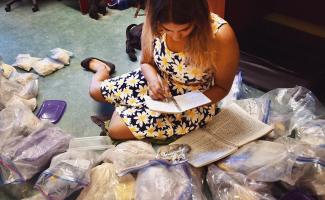
Like a lot of data analysis, a good chunk of her day involves MATLAB, Python, Excel, Word, and “basically things to make graphs with. Things that help me look at the spectrum.”
There’s WebEx calls and emails with her collaborator (Dr. Patrick Gasda). There's inside jokes, too: “Gale Crater has really funny target names. Whenever there’s a funny name, Patrick will send me a message: ‘Today’s target is Gloop’. Like, literally, there’s a target called ‘Gloop’. There’s a hill now called 'Bloodstone Hill', which is just really metal, you know?”
Citizen Science
While some of the data coming from Curiosity (and soon, Perseverance) has temporary time restrictions on it, a lot of the data is available for anybody to look at. In fact, there are citizen science initiatives like Zooniverse, which lets anybody help to identify Martian terrain.
Debarati herself – somebody who works with Mars data – learned from this initiative: "During my first year of my PhD, I Identified frost patterns on Mars. So, it’ll just teach you how to do it. It’ll show you the examples. And then as a citizen scientist, you can go around measuring all of them. In a real way, contributing to science on Mars."
Near the top of this article, I tried to make an argument: isn’t it incredible that you could be at a café (under normal times) and have somebody beside you sit down and do their work studying Mars?
Well, all of us can do that. All from a rover running around on a little dot 100 million kilometres away.
The Office in the Sky
Sometimes when I go back to Edmonton to visit family, I head downtown and walk past my first job out of college: Vue Weekly. The paper no longer exists, but the building itself brings back some fond memories.
Over the last few months, Jupiter, Saturn, and Mars have been appearing earlier and earlier in the sky. I was curious how Debarati – somebody whose day-to-day work is directly influenced by signals coming from that tiny little red dot in the sky – feels when she looks at it. In the same way that when I walk past the building where I had my first real job, what goes through her head?
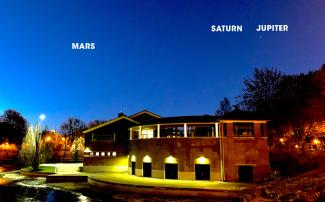
I asked, "How do you feel when you look at your office in the sky?"
She replied, "I think it touches a lot of insecurities as a geologist, because we always need to feel stuff. Geologists like smelling, touching, licking rocks, and I can’t do any of that for Mars. Which is why a part of me ached for stuff I could hold and touch. But yeah, often it just really does seem conceptual. I’m just getting data packets and the realness of it kind of does escape me."
For a brief moment during the interview, I thought Debarati would end there, on a bit of a sad note. But she finished with this:
"It doesn’t register in my brain that humans can do so much without actually having ever been to a planet. We’re learning so many real things about a planet without ever having been on it. When I think about Mars Science Laboratory, which is somewhere else in the universe, it is a little… spacey. I’d never thought of it as my office.
"We’re all sort of working on it together and getting to know it. But it’s not mine to say that is my section. And that’s nice. It’s freeing in a way."
Last Question
P. Astro: "Do you have any clothing that lights up?"
Debarati: "Hahahahahaha, yes! I have many clothings that light up!"
